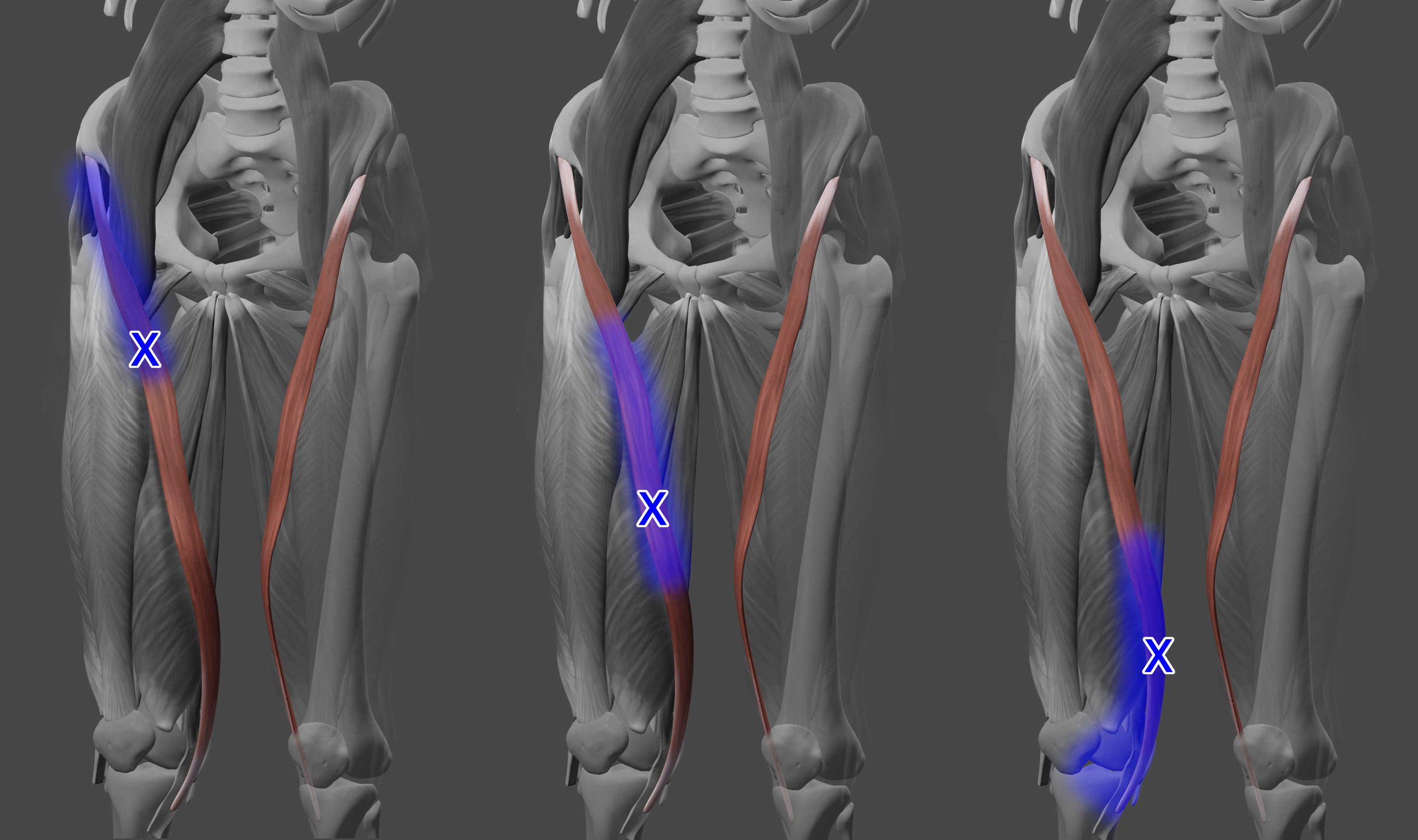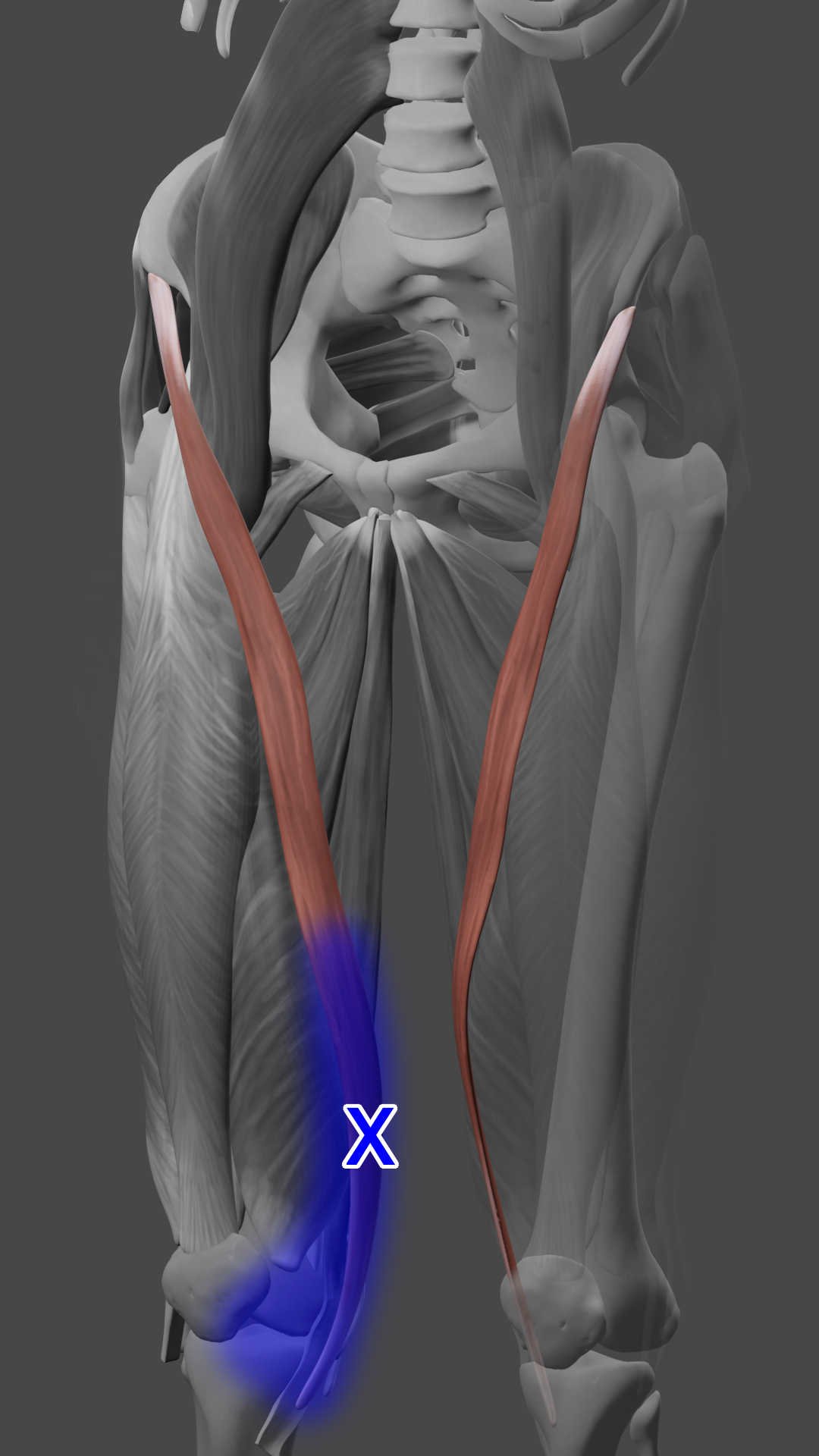Acupuncture for Sartorius Muscle Pain
Sartorius trigger points
How to get relief from sartorius muscle pain?
Do you have thigh or knee pain? Do you have a sartorius strain or hip flexor strain? Read more to learn about sartorius trigger points and why you should consider treating them with acupuncture and dry needling. This method of treatment addresses the root cause and symptoms of sartorius issues in one treatment to relieve pain and restore muscle function.
About the sartorius muscle
The sartorius muscle is the longest muscle in the body and the most superficial muscle in the anterior thigh. Sartorius trigger points can refer pain along the muscle from the front of the hip and thigh down through the medial thigh and to the medial knee. They can also cause leg cramps, problems climbing stairs, and numbness and tingling in the outer thigh, known as meralgia paresthetica. Sartorius trigger points cause a sharp, superficial pain, unlike most other trigger points, which cause a deeper, aching muscle pain.
The sartorius attaches to the pes anserinus tendon along with the gracilis and semitendinosis muscles. Overuse or trigger points in these muscles can lead to pes anserine bursitis which can cause pain and inflammation in the medial knee.
Read more to learn about sartorius trigger points and how acupuncture and dry needling can help relieve thigh pain and knee pain naturally.
Origin and insertion of the sartorius
Sartorius origin:
The origin of the sartorius muscle is at the anterior superior iliac spine (ASIS).
Sartorius insertion:
The insertion of the sartorius muscle is at the proximal, medial shaft of the tibia at the pes anserinus tendon.
Based on the origin and insertion of the sartorius muscle, we can see that it pulls the front of the hip and the medial lower leg closer together. Since it passes through the hip and the knee it has multiple functions that act on both joints.
Sartorius actions
What are the sartorius muscle functions?
Flex hip
Laterally rotate hip
Abduct hip
Flex knee
Medially rotate flexed knee
The sartorius assists flexion, abduction, and lateral rotation of the thigh, in that order of importance. It assists the tensor fasciae latae and iliacus in hip flexion and biceps femoris in knee flexion during swing phase of gait. It also assists the vastus medialis, gracilis, and semitendinosis to support knee medially during single limb balance.
Synergists and antagonists of the sartorius
Sartorius synergists:
Hip flexion: rectus femoris, iliopsoas, pectineus, and tensor fasciae latae
Hip abduction: gluteus medius, gluteus minimus, piriformis, and tensor fasciae latae
Sartorius antagonists:
Hip flexion: gluteus maximus and hamstrings (they are hip extenders)
Hib abduction: adductors group and gracilis (they are hip adductors)
Tensor fasciae latae opposes the sartorius during medial/lateral rotation of the hip
Sartorius Trigger Points
Main complaints related to sartorius trigger points include:
Anterior Thigh Pain
Anteromedial Knee Pain
Medial Thigh Pain
Numbness/Tingling on the Outer Thigh (Meralgia Paresthetica)
Problems Climbing Stairs
Upper/Lower Leg Cramps
The sartorius muscle is referred to as the “surreptitious accomplice” by Travell & Simons since it accompanies other trigger points and sartorius trigger points usually do not form on their own. This is because the sartorius mainly assists other muscles in many of its functions. It crosses the hip and knee joints which explains why it has so many functions and can be an accomplice to many other trigger point patterns.
Associated sartorius trigger points include the rectus femoris, vastus medialis, and tensor fasciae latae muscles.
Sartorius Trigger Point Locations
The three trigger points refer pain along the muscle, often as a sharp or tingling pain rather than deep muscle ache that other trigger points in other muscles tend to have.
The lower sartorius trigger points often refers pain into the medial knee - but it is a more superficial pain, unlike the vastus medialis trigger point which has a deeper aching pain referral pattern.
Upper Sartorius Trigger Point Location
Middle Sartorius Trigger Point Location
Lower Sartorius Trigger Point Location
Signs and symptoms of sartorius trigger points
Superficial thigh or medial knee pain - it is NOT deep in the knee like vastus medialis trigger points
Possible symptoms of entrapment of the lateral femoral cutaneous nerve, causing numbness and parasthesia of the anterolateral aspect of thigh.
What causes sartorius pain and trigger points?
They usually form after other TrPs since this muscle mostly assists other muscles
Sitting in lotus position for long periods of time
Twisting fall
Morton foot structure
Sartorius trigger points can be mistaken for vastus medialis trigger points, knee joint issues, or nerve entrapment
Sartorius strain and sartorius pain treatment
Trigger point acupuncture and dry needling can provide myofascial release in the sartorius by identifying the taut bands of muscle that create the pain referral pattern and eliciting a twitch response with an acupuncture needle to relax the muscle to restore function, improve range of motion, and reduce pain.
Your acupuncturist will palpate for taut bands of muscle to find trigger points in the affected muscle and release them using an acupuncture needle. Other modalities like electroacupuncture, cupping, gua sha, and tui na can also help with thigh and knee pain symptoms.
Over to you
If you liked this article, please share with friends and family who may be suffering with hip flexor, thigh, or knee pain:
Sources:
Travell, J. G., Simons, D. G. (1993). Myofascial pain and dysfunction: The trigger point manual (Vol. 2). London: Lippincott Williams & Wilkins.
Biel, A., & Dorn, R. (2010). Trail guide to the body: A hands-on guide to locating muscles, bones and more. Boulder, CO: Books of Dicovery.
Janda, Vladimír. “Muscle Function Testing.” (1983).
Mochizuki T, Akita K, Muneta T, Sato T. Pes anserinus: layered supportive structure on the medial side of the knee. Clin Anat. 2004 Jan;17(1):50-4. doi: 10.1002/ca.10142. PMID: 14695588.






